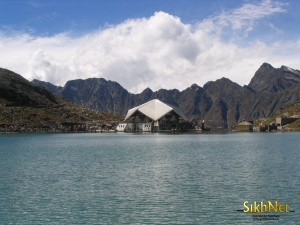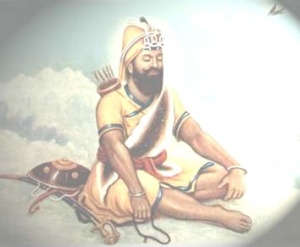Gurdwara Hemkunt sahib
In the Indian epic and Puranic literature, Himalayan landscapes are described as the dwelling places of gods and goddesses. Pilgrimage shrines mark the places where the landforms themselves - mountains, rivers, forests, and lakes - are said to have acquired sacred qualities. High above the tree line, in the midst of a natural rock garden of moss, ferns, and flowers, is one such sacred place: a small, blue-green lake fed by water which cascades down from the surrounding mountain walls. Located in the Uttarkhand Himalayas bordering Tibet and Nepal, it is accessible for only four months of the year. Between June and October, sun and monsoon rains melt the ice and snow that are its namesake. Then, the steep stone footpath that leads to the lake is crowded with pilgrims and tourists. They journey to the base of the route on foot from neighbouring mountain valleys, or from the plains in buses, cars, and trucks, on scooters and bicycles, even by foot. Then for two days they climb upward. Some walk, some ride mules, and some are carried by porters. Finally, at the top of more than a thousand stone steps, the holy lake, the Sri Hemkunt Sahib Gurdwara, and the Sri Lakshman Mandir come into view.
HISTORY
Sikhs believe that this holy place, known as Hemkunt (lake of ice), is the tap asthan (place of meditation and prayer) at which the tenth and final living Guru of the Sikhs achieved union with God in his previous incarnation. From there, the Guru was summoned by God to be reborn into the world to teach the people the true path. The temple built on the shore of the lake commemorates his mission. It also shelters the Guru Granth Sahib, the eternal scriptural Guru for the Sikh community. The community is itself recognized as a collective Guru, and pilgrims, as they walk the path toward Hemkunt, share the sacred journey with its members. In this way, all three forms of the Guru - the source of spiritual guidance - are understood to be present at Hemkunt. Sikh pilgrims go there to be inspired to walk the same difficult path that the Guru walked, both in body and in spirit, and to, through the Guru's grace, realize their connection with God in the same place where the Guru realized his. At Hemkunt Sahib, Sikhs feel closer to the Guru and, through the Guru, closer to God.
Gurudwara Hemkunt in the Himalayas is also regarded as one of the holiest places of the Sikhs. It was there that Sri Guru Gobind Singh the tenth and last Guru of the Sikhs is reported to have meditated in his previous life.
In 'Bachitar Natak' the great Guru relates his story in the following words- "I shall now relate my own story, how God sent me into this world. I was busy performing penance on the hills of 'Hemkunt' where seven peaks are prominent. The place is called 'Sapt Shring’ where King Pandu had performed Yoga, there I practiced austerity and worshipped the god of death. He writes in his autobiography that Ram Chander son of Raja Dasrath had two sons Lava and Kushu. Lava and Kushu ruled over Northern India for many years. They remained good friends during their rule and they colonized two important cities Lahore and Kasur in Punjab. But when they died their sons could not tolerate each other. They became great enemies. In order to get their supremacy they quarreled with each other, One grand son of Lava named Sodhi won the battle and became the king of Punjab. The grandsons of Kushu being defeated took shelter at Banaras. There they learnt the Vedaas.
Due to their knowledge of Vedaas, they were nick named as Bedees. The Guru writes -
“Lavee sarab jeete Kushee sarab haare. Bache je balee praan lai kai sidhaare. Chattur bed pathiyang keeyo Kashi basing. Ghanai barkh keene tahaan hee niwasing. (52)”
One-day king Sodhi remembered his relatives living at Banaras. He made up his mind to call them. He sent a messenger and all Bedees reached in the Darbar of King Sodhi at Lahore. King Sodhi asked them to recite the four Vedaas according to the divine process. When the Bedees recited three Vedaas and started to read the fourth Vedaa, the King Sodhi got up from his throne. He asked the leader of the Bedees to take his royal seat. He offered his kingdom to the Bedees with great honor. He himself decided to go to forests in order to contemplate the Name of God.
When king Sodhi got prepared for his new abode, the newly crowned king Bedee said, "As you have gifted us the worldly kingdom after hearing three Vedaas, similarly in Kalyug we would offer you the Divine Kingdom in our third incarnation. In Kalyug Guru Nanak was born as first Divine master. He was called the true Patshah. After reigning as the Divine King in the form of Guru Nanak Dev, Guru Angad Dev and Guru Amar Dass, he offered his Divine kingdom to Sodhi Patshah Guru Ram Dass Ji.
The Sodhi king grandson of Lava proceeded towards jungles and he selected a very beautiful place for his abode. He worshiped there the name of God for many thousand years.
About his own life Guru Gobind Singh writes in his auto-biography as under: -
Ab main apnee katha bakhaano. Tap saadhat iih bidh muhe aano. Hemkunt Parbat hai jahaan, Sapt sring sobhit hai tahaan. Satptsring teh naam kahawa Pand raaj jahan jog kamava teh ham adhik tapasaya sadhi mahakaal akalka aradhi
The Guru Ji tells us about his previous incarnation, that in the Himalayan range, where there is Sapt Sring Mountain, on that hill he meditated the Name of God. In his meditation when he became one with God, then the Almighty ordained him to take birth in India in order to crush the cruel rulers.
"My father and mother meditated on the incomprehensible. They both practiced the highest yoga through diverse spiritual efforts. Their devout service in the love of God pleased the Almighty who commanded me to take human form in this world. I did not like to come. God sent me into the world with a mandate saying, 'I cherish thee as my son and send thee to establish the path of truth. Go into the world and establish virtue and keep the people, away from evil.'When my father came to Triveni (Allahabad) he daily devoted himself to meditation and charity. There at Allahabad the dazzling light manifested itself into human form."
Ih bidh karat tappsaya bhayo Davai te ek roop havai gayo.
Chit na bhayo hamro aavan kaih Chubhi rahee srut Prabhu chaman maih Jio tio Prabh ham ko samjhaayo. Im Kaih kai ih lok Pathaayo.
The Guru was so much engrossed in the Name of God, that he did not want to take re-birth. But some how the Almighty, persuaded him and he was born at Patna Sahib. His mother was Mata Gujri and his father was ninth Guru Tegh Bahadar Sahib.
As Guru Gobind Singh had mentioned, the place of his previous incarnation in his auto-biography, many sikh scholars tried very hard to locate the exact place. In this field the names of Sant Sohan Singh, Hawaidar Moan Singh, Sant Thandi Singh and Sant Surat Singh are taken with great respect. They dedicated their whole life to locate the exact place in order to construct the Gurdwara Hemkunt Sahib. In this field the services of the Hem Kunt-Trust are laudable. The Trust has constructed roads leading towards Hemkunt Sahib and for the benefit of the travellers it has built big Gurdwaras on the way.
This 'lake of ice' is also sacred to the hill people who live in the valley below. They tell of the gods Lakshman, Hanuman, Shiva, and Vishnu, the tales of their deeds woven together with images from local landscapes. Long before the Sikhs knew the lake as the Guru's tap asthan, these people knew it as Lokpal, and made annual pilgrimages to its shore. For them, as for Sikhs, the journey continues to be an act of devotion, and the holy lake itself is a place for prayer and worship - a place where wishes can be fulfilled.
External Links
| JOURNEY SHRI HEMKUNT SAHIB |
ROUTE 1 - Haridwar ROUTE 2 - Paonta Sahib Rishi Kesh ♣♣ Dev prayag ♣♣ Srinagar ♣♣ Rudra Prayag ♣♣ Karna prayag ♣♣ Nanda prayag ♣♣ Joshi Math ♣♣ Vishnu prayag ♣♣ Gurudwara Gobind ghat ♣♣ Gurudwara Gobind Dham ♣♣ Hemkunt Sahib |


